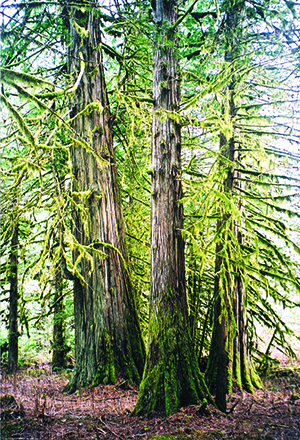Western Red Cedar

Western red cedar (Thuja plicata) makes up approximately 8% of British Columbia’s total growing stock, and is one of the most commercially valuable species. The wood is straight-grained, non-porous, and has a distinctive aroma. Weather-resistant and highly resistant to decay, western red cedar is ideally suited to exterior applications where durability and dimensional stability is required. Its unique properties make it ideal for weather-resistant applications including roof shingles, exterior siding and cladding, decking, doors, outdoor furniture, portable buildings, poles, posts, fences, ship and boat building, and boxes and crates.
Western red cedar is a fairly lightweight wood, which is moderately soft and low in strength. It is known for its excellent working properties, with good machining qualities. It planes and shapes well and can be sanded to a smooth finish. It is one of the few wood species that, as lumber, is naturally at home in the outdoors. When properly finished, western red cedar will last for decades — even in harsh environments. Its natural resistance to moisture, decay, and insect damage make Western red cedar the ideal choice for a surface that is exposed to sun, rain, heat and cold all year round.
Its heartwood varies in colour from light straw to pinkish red to deep, rich brown. With this dark, attractive colouring, Western red cedar also has many interior applications and is popular for use in doors, windows, ceilings, wall paneling, and millwork. Due to its dimensional stability, it is perfectly suited to uses like sauna panelling, moulding, and window blinds. This wood is also a good choice for musical instruments due to its superb acoustic resonance properties.
Western red cedar can be graded structurally under National Lumber Grades Authority (NLGA) grade rules. However, western red cedar is more often graded for appearance and specialty applications. These include clears, shop, fence, paneling, siding and other NLGA grades.


NSDA Architects. Neale Staniszkis Doll Adams. Vancouver. Constructors: Wayne Watson Construction Ltd., Prince George, BC. Client: The Canadian Cancer Society. (docket 2613.) 

Home outdoor cedar deck with furniture and open umbrella during nice bright day. Horizontal layout. ; Shutterstock ID 416566519; user id: 13381306; user email: [email protected]; user_country: China; discount: 0% 




